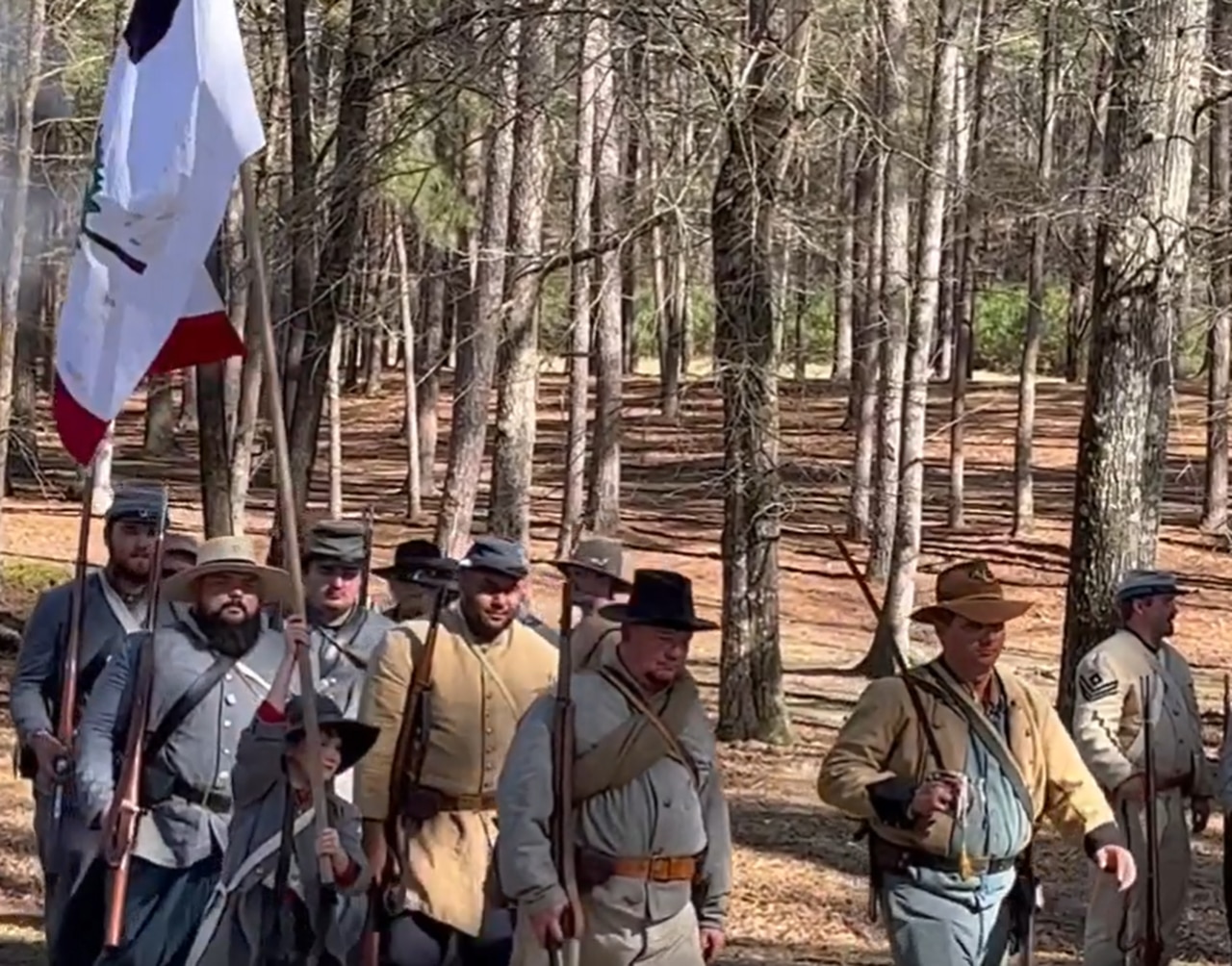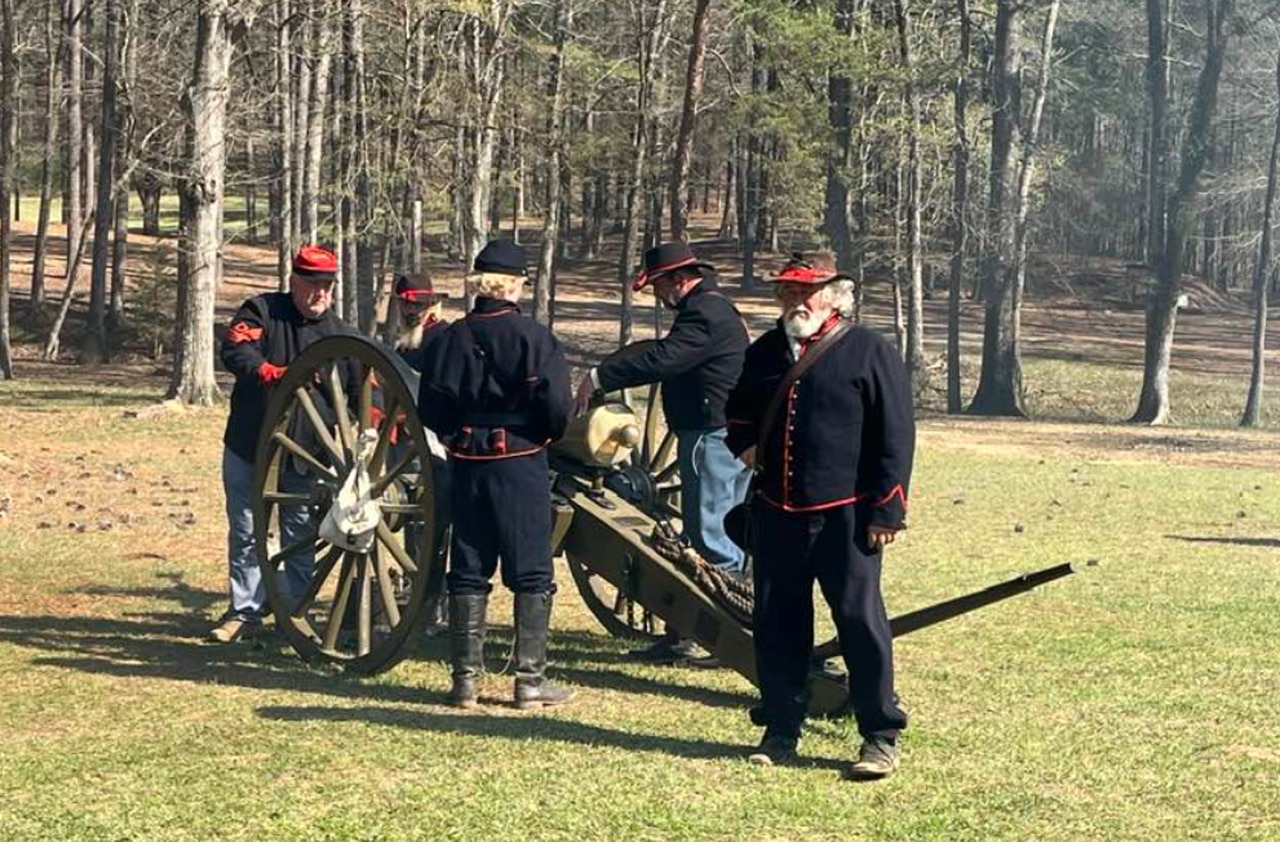Civil War re-enactment returns to Tannehill State Park
As federal cannons blasted on Sunday afternoon, actors portraying Confederate soldiers fired off their muskets and fell to mock deaths in a semi-wooded field at Tannehill Ironworks Historical State Park.
It had been eight years since the last Civil War battle re-enactment at the 1,500-acre state park on Confederate Parkway in McCalla, but the re-enactors returned Saturday and Sunday, acting out the role of Yankees and Rebels on the battlefield.
“They are coming back in popularity,” said Scottie Myers, who portrayed a Union officer over the weekend. “People are waking up and saying, ‘Hey, I enjoyed that. I want my children to see it.’”
The real action at the Battle of Tannehill Furnace nearly 200 years ago didn’t unfold quite this way.
Three companies of the Eighth Iowa Cavalry swept through the area on March 31, 1865, as part of Union General James H. Wilson’s raid on Alabama war industry sites. Union soldiers burned the ironworks and cabins, leaving the foundry, tannery and gristmill in ruins. The ironworks had provided pig iron used in making Confederate supplies.
“That was toward the end of the war; there were really no (Confederate) troops in the area (to resist),” said Meyers, who led the Union troops on Sunday at Tannehill. “The war was pretty much over. Wilson’s Raid came through mainly to destroy anything – gristmills, stores, railroads, iron furnaces – that could be used for war munitions.”
Like many re-enactors, Myers has full regalia of both Union and Confederate soldiers. “Whatever role is needed,” said Myers, who owns the Pleasant Ridge antebellum plantation house in Camden, built in 1838 and vacant for more than 50 years before he and his wife, Tammy, bought and restored it. They run it as a bed and breakfast inn and offer tours to the public.
“We’re immersed in the history,” he said. His wife wore a vintage dress Sunday at Tannehill and held a vintage parasol as she watched the skirmish unfold.
On weekends, they’re often off at Civil War re-enactments that take place across the country, from the Battle of Shiloh in Tennessee, to Gettysburg in Pennsylvania.
The performances on Saturday and Sunday at Tannehill were generic battles, with the Confederates winning a battle on Saturday and the Union winning a battle on Sunday.
“We go to an event, and whatever the event needs, we try to accommodate that,” said Don Green of Saraland, has done about eight re-enactments a year for 22 years. “We have a Confederate designation, and we have a federal designation. Our company guideline is, ‘you will wear the blue.’ Down this far, there are people that refuse to wear the blue. This is a hobby, where you have to portray both sides.”
Actors portraying Union troops fire a cannon at Tannehill Ironworks State Park on Sunday, March 5, 2023. (Photo by Greg Garrison/AL.com)
Bringing the Confederacy back to life as a historical tribute runs the risk of romanticizing the war and downplaying the horrors of slavery and the bloody magnitude of the conflict, some critics have noted. The removal of Confederate monuments across the South shows the Civil War remains a political powder keg and a culturally sensitive topic.
Myers said reenactments are for historical educational purposes only, not intended to be political. The actors help give a glimpse into the past, of what a Civil War battle may have been like, he said.
“It’s totally different from any other kind of warfare that we have today,” Myers said. “We bring in fellas and they want to fight Rambo-style and we got to say, ‘No, that’s not what we’re all about.’ We’re about history.”
The re-enactors have their own traveling regiments and most of the soldiers are required to be able to flip and play whichever side of the war is needed.
“We have actual structure, actual rank, based on merit,” Myers said.
The leaders need to be like human resources directors to orchestrate the battles, he said.
“You have to deal with all these people, and put on something that everyone will enjoy, including the soldiers,” Myers said. “If the soldiers don’t enjoy it, they won’t be back. Basically, we are actors. We are historians too. We have to be actors out on the field.”
Myers is a member of an organization called the 1st Division- Southern Re-enactors Association, which started five years ago, he said. It has members from across the South.
He was one of 2,000 people who took part in a re-enactment for the 155th anniversary of the Battle of Shiloh last year, he was one of 2,000 re-enactors. It went really well.
“It takes about three years of preparation to put on national events like Shiloh, Gettysburg,” Myers said. “You’ve got to get land leases, firewood, ambulance support. It takes a lot. It costs a lot of money to do a national event. These events, we’re really lucky the parks let us use the property. They provide the firewood and utilities for the men.”
The re-enactors set up camp in period tents for the weekend, eating food cooked over open fires.
The height of Civil War re-enactments was during the war centennial period from 1961-65, a time of actual turmoil and societal upheaval during the civil rights movement. Popularity has waned at times, but Myers said he’s seeing an increased interest.
That helped bring it back to Tannehill.
“Their staff decided it was okay to do,” Myers said. “People kept requesting it. We had signature drives, petitions to let us come back and do it.”
John “Pork Chop” Kenworthy drove over from his home in Long Beach, Mississippi to play a Confederate soldier in the weekend skirmishes.
“I have ancestors that fought on both sides,” Kenworthy said.
Jacob Lewis of Mobile borrowed a Confederate gray uniform to take part in his first re-enactment. “I loved it, had a ton of fun,” he said.
Clay Westfaul, from Vanleave, Mississippi, said he started doing re-enactments in 2021, at the 158th anniversary of the Battle of Chickamauga, which took place in September 1863 in Chattanooga. He has been doing an event about once a month, working with re-enactors from the Southern group and also a group from Michigan and Wisconsin. In July 2022, he played a Minnesota soldier fighting for the Union at Gettysburg, with unit-specific attire down to Corps badge, canteen and rifle. He bought an original 1832 Prussian musket, with a bayonet, similar to about 100,0000 that were given to Union soldiers in 1862.
“You experience a taste of what the Civil War was,” Westfaul said. “This is a period of American history that is misunderstood. What better way to portray history than to live it.”
After Sunday’s demonstration, the war dead were resurrected. The Union and Confederate soldiers lined up, side by side, and fired off a celebratory salute with blanks over the heads of the audience, which responded with applause.
Ten more Civil War re-enactments will be staged in Alabama this year, in Newton, Ohatchee, Spanish Fort, Stevenson, Jacksonville, Gainesville, Decatur, Gallant and Crossville.
The re-enactors were happy to be back at Tannehill for the first event of the season.
“We’re very thankful to them for allowing us to come back,” Myers said.

A group of re-enactors portray a Confederate regiment at Tannehill Ironworks State Park on Sunday, March 5, 2023. The boy carrying the flag at left is Jacob Kenworthy, followed by his father, John “Pork Chop” Kenworthy, of Long Beach, Mississippi. (Photo by Greg Garrison/AL.com)
